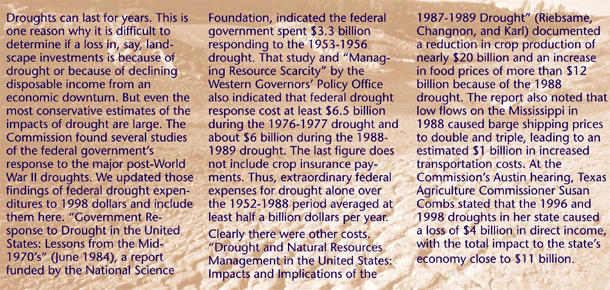|
|
| Return to Table of Contents |
From Relief to Readiness For years, farmers and ranchers, tribes, public land managers, scientists, economists, small business owners, conservationists and wildlife managers, small and large municipalities, counties, states, regional entities, and the federal government have grappled with the far-reaching consequences of drought. Numerous papers, reports, and books have recorded and analyzed the impacts of drought. They have pointed out over and over again that drought planning and proactive mitigation programs may well reduce the need for huge federal emergency relief expenditures in drought-stricken regions—usually to assist farmers and ranchers and rebuild local economies. They have also indicated that planning and proactive mitigation may lessen conflicts over competition for water during drought. Many states and local governments include drought in their comprehensive water management, land-use, and long-term planning strategies. Some have devised separate drought plans. These government entities know best about local resources and local priorities, and they know how to communicate with their constituencies and stimulate people to action. Some farmers, ranchers, and other businesses also incorporate drought concerns into their risk-management assessments. Private entrepreneurs and nonprofit groups with an interest in water management and environmental issues work with governments to carry out drought education projects and water conservation initiatives that rely on the cooperation of the general public. In response to individual challenges over the years, Congress has enacted laws to create federal programs aimed at lessening the impacts of drought, and special congressional appropriations of federal taxpayer dollars underwrite much of the drought relief. Despite such
well-intentioned efforts, from a national perspective this country
relies on a patchy approach to reduce the impacts of drought. And
despite the major role that the federal government plays in responding
to drought events, no single federal agency is in a lead or coordinating
position regarding drought. State, local, and tribal governments must
deal individually and separately with each federal agency involved in
drought assistance. Crisis management—rather than planning and
proactive mitigation measures—often characterizes the federal response
to drought emergencies.
|
|
|

